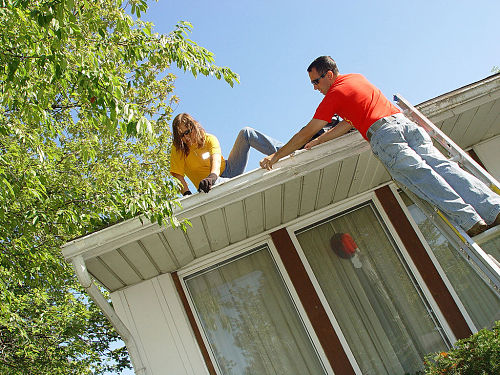
Fall Home Maintenance Tips Twin Cities Homeowners

Fall fell on us on September 23 and if you haven’t yet begun your autumn home maintenance chores you’d best get crackin’! We’ve gathered up some tips, specific to Twin Cities’ homeowners, to help you get started.
Fire prevention
The incidence of home fires tends to increase during fall and winter, according to the American Red Cross and 21 percent of home fire deaths were in homes with inoperable smoke alarms. Whether they weren’t operating because the batteries were dead or for some other reason isn’t cited in the study published by the National Fire Protection Association, but the statistic is one that should send you running to check your smoke alarms. In fact, check them monthly throughout fall and winter.
Change the batteries, even if they’re functioning. We like to change ours when we switch from Daylight Savings to Standard time, which happens at 2:00 a.m. November first this year.
Strip it
Windows and doors are notoriously leaky, allowing our toasty indoor air out and that frosty stuff in. Weather-stripping is the way to stop the leaks, but it’s not something that lasts forever and periodically needs to be replaced.
If you can rattle the windows or see daylight around the door frame, head to the hardware store for a fix. If you aren’t sure what to buy, This Old House’s “The Essential Guide to Weatherstripping” will point you in the right direction. Get tips on installing the weather-stripping at the U.S. Department of Energy’s website.
Yes, it’s a bit of a time-consuming task, but one well worth performing. Replacing worn-out weather-stripping can save 10 to 15 percent on your energy bills this winter.
Now that the air is staying put
Furnaces typically last from 15 to 20 years and the life cycle of a heat pump ends at around 16 years. If you’re on the edge of either’s life span, call in an expert to have your HVAC system inspected. That way you can ensure that all that air you’ve decided to keep inside the home is toasty.
Even newer furnaces should be inspected but, at the very least, routinely replace the filter. This is the ideal time to stock up on filters so that you can replace them monthly through fall and winter.
Leaks and ice dams and roof damage, oh my!
One of the most costly problems that can occur in winter is heat loss through the attic or roof. The heated air melts snow and causes ice dams. These, in turn, may cause water to leak into the home and permanent damage to the roof. Have you priced roof repairs lately?
Prevent future problems by ensuring the attic has adequate insulation and that the roof has appropriate ventilation. Seal any air leaks in the attic while you’re at it.
Then, head on down to the basement to wrap the pipes and heat ducts. Inspect the pipes beforehand and don’t wrap any that have leaks.
Move outside
No, not permanently; but just long enough to ensure that the exterior of the home is ready for our wild and wooly Twin Cities winter.
Start your inspection at the top of the house and work your way down. How are those gutters? Clean them out and check for leaks. Ensure that the downspouts will direct water away from the house.
Check the siding, if you have it. Caulk it, if needed.
Hopefully you’ve blown out the irrigation system and wrapped the pipes. If not, get this done as soon as possible.
Inspect the landscaping for possible winter hazard conditions. Trim dead branches that may fall on the home or hire a licensed and insured arborist to do it for you.
Clean your outdoor furniture and grill and cover or store them for the winter. Think how good it will feel to be able to just whip off the cover and fire up the barbie when grilling weather sets in.
Sure there are more tasks you can perform to get your home winter-ready, but we rather think this honey-do list we’ve put together for you covers the basics of setting up your home to be safe, healthy and comfortable all winter long.
Image: By U.S. Navy photo by Chief Mass Communication Specialist Lucy M. Quinn, via Wikimedia Commons



